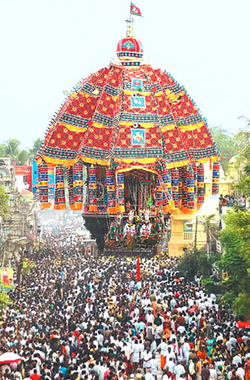Thiruvarur
Chola Nadu | |
|---|---|
Municipality | |
 Devotees pulling the Chariot | |
| Coordinates: 10°46′23″N 79°38′13″E / 10.773°N 79.637°E | |
| Country | |
| State | Tamil Nadu |
| District | Thiruvarur |
| Region | Cauvery Delta |
| Government | |
| • Type | Selection Grade Municipality |
| • Body | Thiruvarur Municipality |
| Area | |
• Municipality | 10.47 km2 (4.04 sq mi) |
| Elevation | 3 m (10 ft) |
| Population (2011)[1] | |
• Municipality | 58,301 |
| • Density | 5,600/km2 (14,000/sq mi) |
| • Metro | 96,255 |
| Languages | |
| • Official | Tamil |
| Time zone | UTC+5:30 (IST) |
| PIN | 610001 |
| Telephone code | 914366 |
| Vehicle registration | TN:50 |
| Website | www.thiruvarur.in |
Thiruvarur (Tamil: [t̪iɾuʋaːɾuːɾ]) also spelt as Tiruvarur is a municipality in the Indian state of Tamil Nadu. It is the administrative headquarters of Thiruvarur district and Thiruvarur taluk. The temple chariot of the Thyagaraja temple, weighing 360 tonnes (790,000 lb) and measuring 96 feet (29 m) tall is the largest temple chariot in India. Thiruvarur is the birthplace of Tyagaraja, Muthuswami Dikshitar and Syama Sastri, popularly known as the Trinity of Carnatic music of the 18th century CE. Thiruvarur Thiyagarajaa Swaamy temple is older than Tanjore big temple.
Thiruvarur was a part of Thanjavur district until 1991. The Odambokki river passes through the centre of the town.[2] Thiruvarur covers an area of 10.47 km2 (4.04 sq mi) and had a population of 58,301 as of 2011.[3] Out of total population of Tiruvarur, 1,403,348 in the district, 257,795 are in urban area and 1,006,482 are in rural area. 65,220 households are in urban, 261,999 are in rural area. It is administered by a selection grade municipality. The town is a part of the Cauvery delta region and agriculture is the major occupation. Roadways are the major means of transportation with a total of 94.06 km (58.45 mi) of district roads including three national highways passing through the town. The town was one of the five traditional capitals of the Chola empire, with one of the emperors of the dynasty, Kulothunga Chola I, having it as his capital. The town is believed to be of significant antiquity and has been ruled, at different times, by the Medieval Cholas, Later Cholas, Later Pandyas, Vijayanagar Empire, Thanjavur Nayaks, Marathas and the British. The town is known for the Thyagaraja temple, and the annual Asian biggest chariot festival held in the month of April.
- ^ "Census India 2011". Office of The Registrar General and Census Commissioner, Ministry of Home Affairs, Government of India. Retrieved 5 March 2016.
- ^ Tamil Nadu Urban Infrastructure Financial Services Limited 2008, p. 5.
- ^ Tamil Nadu Urban Infrastructure Financial Services Limited 2008, p. 6.
